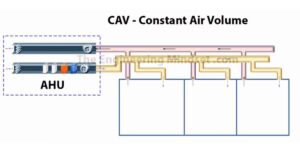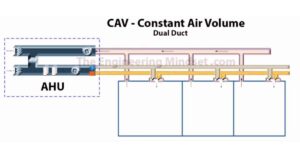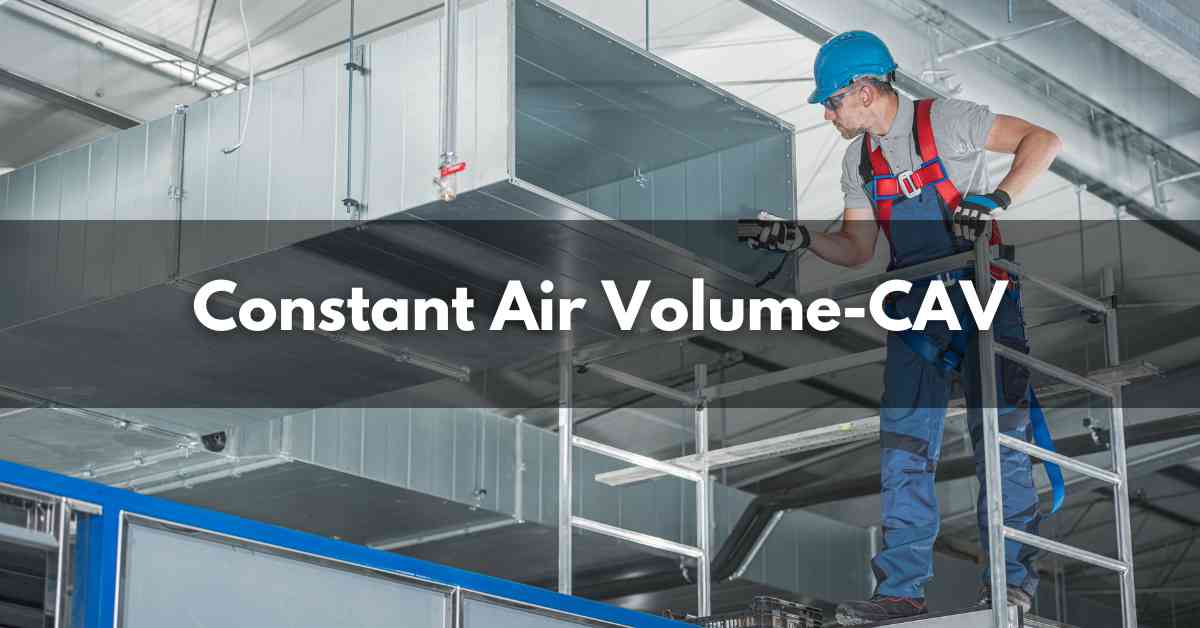Constant Air Volume (CAV) is a type of HVAC system used for heating, cooling, and ventilating. In this article, we’ll explore the basics of CAV systems, including their main components and how they work. CAV stands for Constant Air Volume, and it delivers conditioned air throughout a building. New buildings are using CAV systems less often because Variable Air Volume (VAV) systems are replacing them. VAV systems offer better control over different zones and use less energy. Check out the YouTube tutorial on CAV systems at the end of the article.
What is Constant Air Volume-CAV?
Constant Air Volume (CAV) is a type of HVAC system. In a simple CAV system, the airflow is constant, but the temperature of the air changes to match the heating or cooling needs of a room.

Most CAV systems are small and handle only one zone. However, there are variations like CAV with reheat, CAV multizone, and CAV primary-secondary systems that can handle multiple zones and larger buildings.
New central CAV systems are rare in mid- to large-sized buildings because variable air volume (VAV) systems are more energy-efficient. But in small buildings and homes, CAV systems are popular due to their simplicity, low cost, and reliability. These smaller CAV systems often use on/off controls instead of adjusting the air temperature.
There are two common types of CAV systems for adjusting air temperature: the terminal reheat system and the mixed air system.
The terminal reheat system cools the air to the lowest necessary temperature for a space, which can lead to energy waste but provides comfort.
The mixed air system uses two air streams—one for the coldest and one for the hottest needed temperature. It mixes these air streams to balance the temperature in the space but isn’t as good at controlling humidity.
CAV System Basics
CAV (Constant Air Volume) systems have some limitations. They provide air at a constant volume, but the temperature can vary. Typically, the system delivers air at around 13°C (55°F), but this can be adjusted. The amount of air supplied depends on the size of the area being conditioned and the activities in the room.
For example, a small room might need 3 cubic meters per second of air, while larger rooms might need 20 or 30 cubic meters per second. A large building could need even more. For a 40-story building with one huge AHU on the roof, the required air volume could be very high.
Issues with CAV Systems
One problem with CAV systems is that all rooms connected to the AHU receive the same temperature air, regardless of their individual heat load. For example, a busy summer meeting room will get the same air temperature as an empty adjacent room. This inefficiency wastes cooling energy.
Fans in CAV systems run at full speed all the time. Variable Speed Drives (VSD) can reduce motor speed to improve efficiency. Converting a CAV system to a Variable Air Volume (VAV) system is challenging and requires significant modifications. However, it can result in energy savings, even though CAV systems are cheaper to install and easier to operate.
CAV System Configuration

In the CAV system diagram, you’ll see that all rooms connect to the main duct, and temperature control happens only at the AHU. This setup works well if all rooms have similar cooling or heating needs. If rooms have different needs, it might be better to use separate AHUs for each or install terminal re-heaters.
Dual Duct CAV System
Dual duct CAV systems are less common today but can still be found in older buildings. This system uses two ducts: one for cold air and one for warm air. Dampers in each room mix the air to achieve the desired temperature. The return air goes back to the AHU for recycling or expulsion.

This system offers better thermal control but lacks humidity control and is not very energy efficient. To improve efficiency, ensure temperature reset controls are enabled. These controls adjust the temperature of the hot and cold air streams to the lowest acceptable levels, reducing the overall cooling and heating load.
Difference Between Constant Air Volume and Variable Air Volume
Constant Air Volume Systems
CAV systems maintain a constant airflow and adjust the air supply temperature to meet indoor conditions. For example, on a hot summer day, a CAV system provides colder air to cool the building. In chilled water systems, the cooling effect comes from the cold water flow to the fan coil unit, which the water flow controller adjusts based on thermostat settings.
CAV systems work well in single-zone areas with stable loads, like auditoriums, theaters, and museums. They are less efficient in multi-zone applications because they require duct heaters to provide different temperatures for each zone.
For example, consider a multi-zone CAV system with:
- An air-handling unit (AHU) serving three zones (A, B, and C)
- Each zone having its own thermostat
- The AHU receiving cold water from a chiller with a cooling tower
- Duct heaters on the main branches for each zone
If the thermostats are set to 55°F (A), 68°F (B), and 72°F ©, and the AHU supplies air at 55°F, the system heats the air for zones B and C after serving zone A. This process wastes some cooling energy and consumes extra power for duct heaters.
Variable Air Volume Systems
VAV systems maintain a constant air temperature and adjust airflow based on the load. VAV systems can be single-zone, multi-zone, or dual duct configurations. They are best suited for multi-zone systems.
Dual duct VAV systems use separate ducts for hot and cold air. Each zone has a plenum where the airflow is mixed to achieve the desired temperature. This system is the most expensive to install, operate, and maintain.
In multi-zone VAV systems, VAV boxes control the airflow to each zone, while the cold water flow to the fan coil unit remains constant. VAV systems are most effective in buildings with variable loads across multiple zones, such as malls, hotels, and office buildings.
Instead of reheating air as in CAV systems, VAV boxes adjust the airflow to maintain a constant temperature for each zone.
Conclusion
CAV systems are not suitable for every building. But, they can be very cost-effective and efficient in places like concert halls, gymnasiums, and warehouses. Use CAV systems in situations where you don’t need to change the air pressure or speed often. They work best in stable environments with less climate variation.
FAQs
How does a CAV system work?
A CAV unit runs the fan and compressor at full power until the temperature reaches a set level. Then, the compressor turns off. This on/off cycle isn’t very good at keeping the temperature steady. CAV systems are small and control only one area.
How does a CAV system operate?
Fresh outdoor air enters the AHU, gets filtered, heated or cooled, and then a fan blows it through the ducts to different parts of the building. There are several branches coming off the main supply duct.
What is the difference between VAV and CAV?
Ventilation systems can be constant air volume (CAV) or variable air volume (VAV). CAV systems provide a constant airflow but with changing temperatures. VAV systems offer variable airflow but keep the temperature steady.
What is a constant volume AHU?
A constant volume AHU provides a fixed airflow rate at a constant temperature (usually 55°F) for each zone. This airflow rate is based on the cooling needs of that zone.
Read More – Types of Cooling Towers: A Comprehensive Guide











